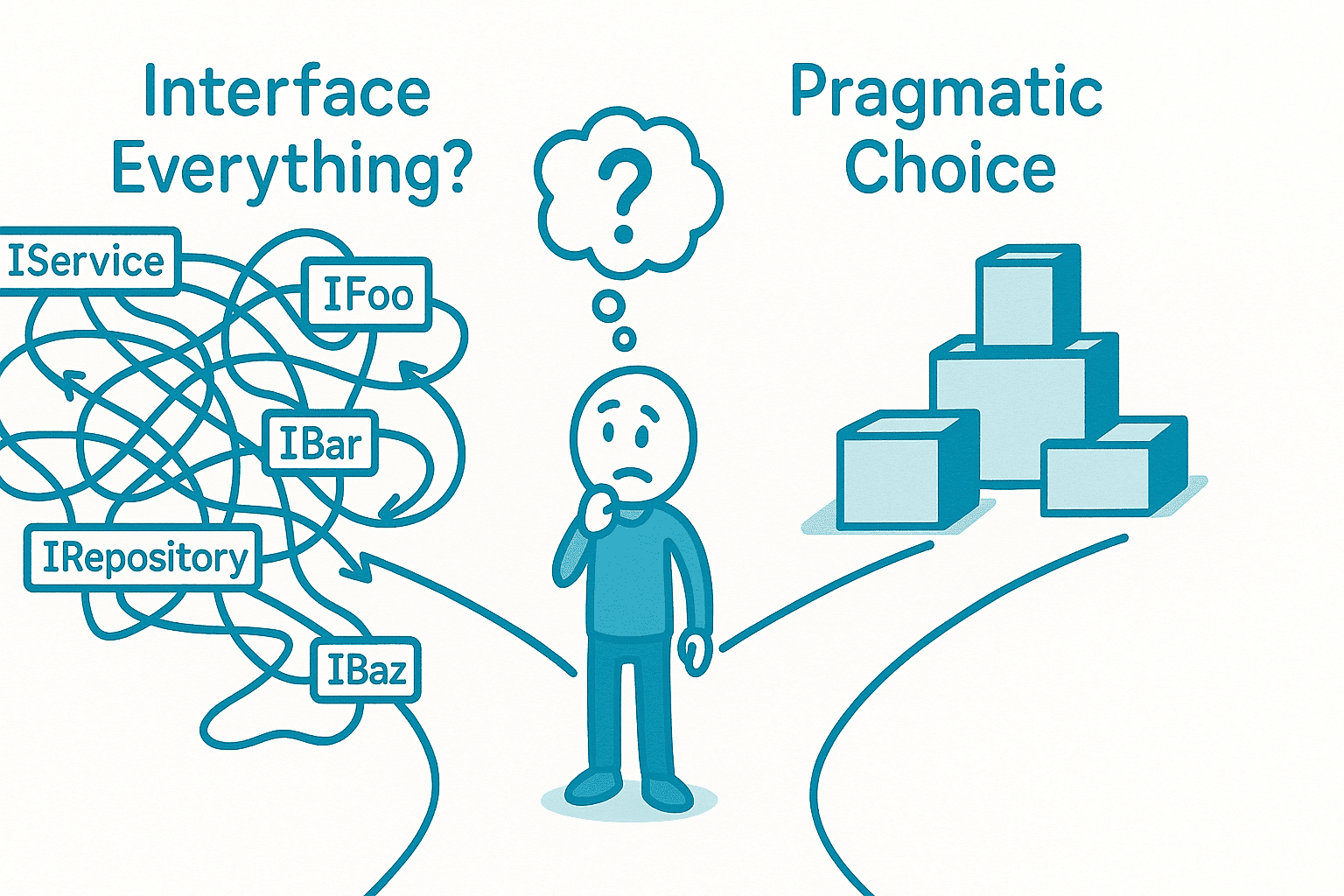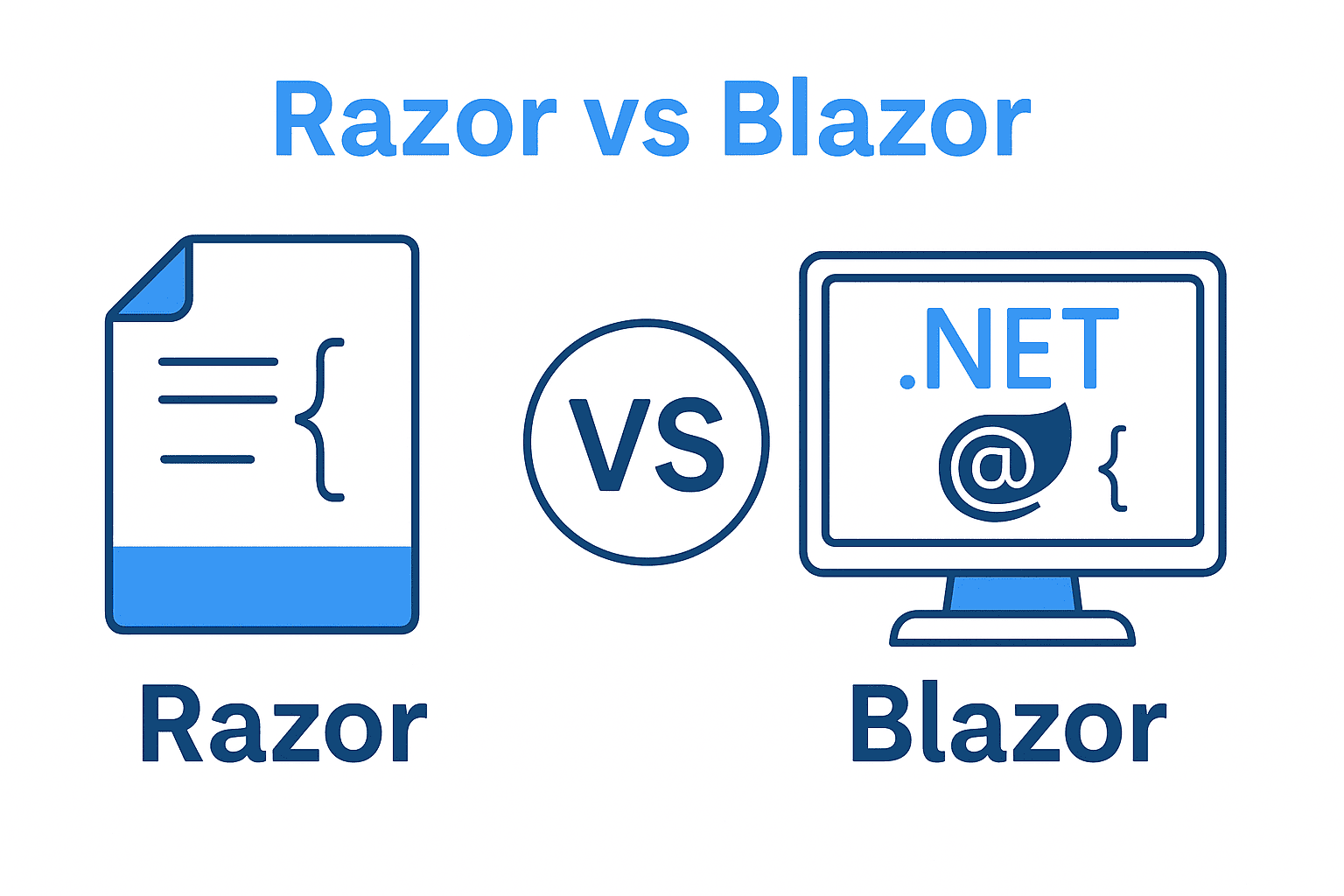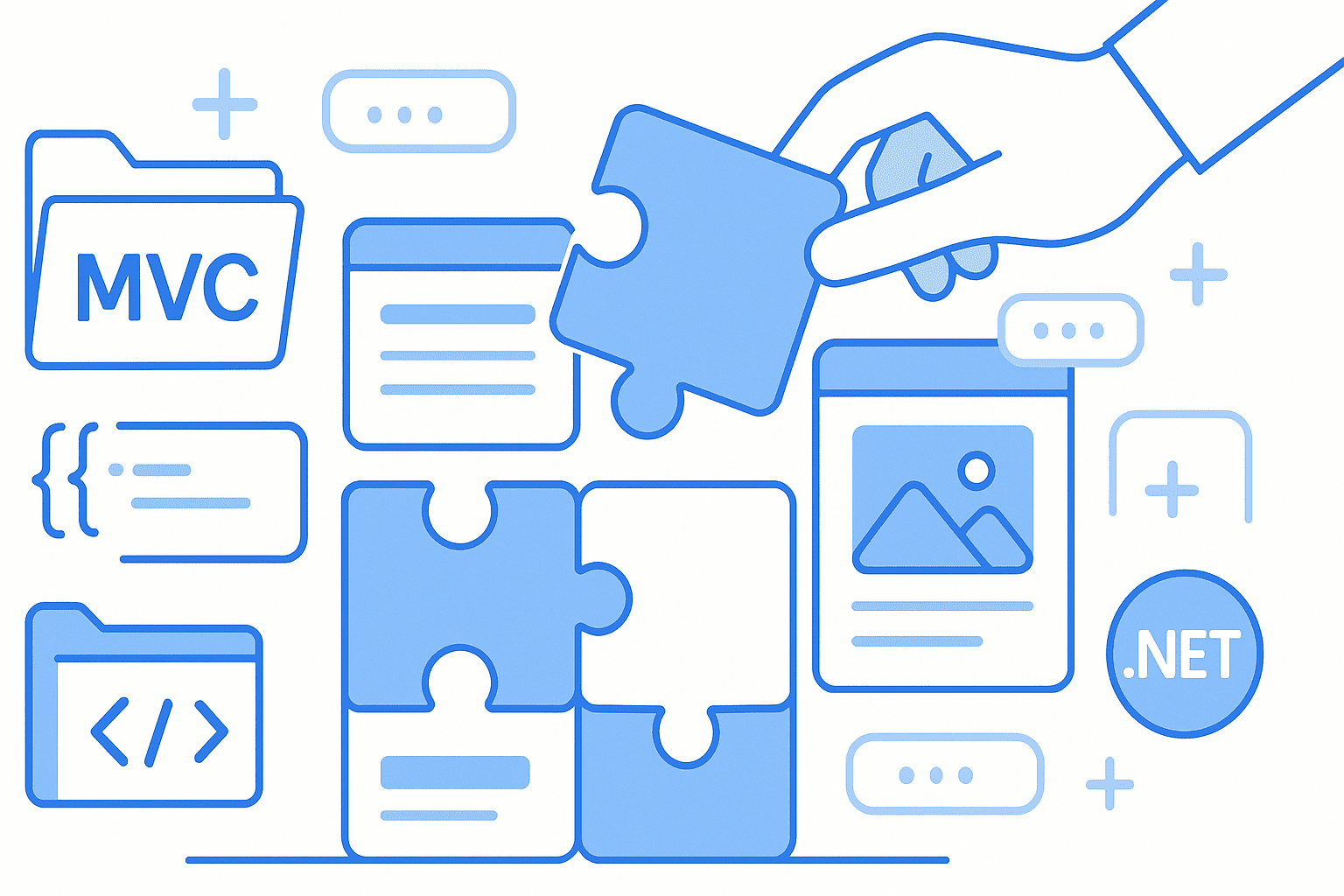Introduction: Questioning Convention
The software development community has long championed interfaces as a fundamental best practice in object-oriented programming. However, a growing number of experienced developers are questioning whether the widespread, almost reflexive use of interfaces has become an anti-pattern rather than a solution. This article explores the often-overlooked downsides of interface overuse, examines practical alternatives, and provides guidance on when interfaces genuinely add value versus when they create unnecessary complexity.
The Problem: Stereotypical Interface Overuse
The Classic Example
Consider this common scenario that many .NET developers have encountered:
public interface IOrderService
{
void PlaceOrder();
}
public class OrderService : IOrderService
{
private readonly IInventoryService _inventory;
private readonly IPaymentService _payment;
private readonly IEmailService _email;
public OrderService(
IInventoryService inventory,
IPaymentService payment,
IEmailService email)
{
_inventory = inventory;
_payment = payment;
_email = email;
}
public void PlaceOrder()
{
// Implementation using injected services
}
}
This pattern has become so ubiquitous that many developers create interfaces reflexively, without questioning whether they're truly necessary. The result is codebases littered with one-to-one interface-to-implementation mappings that provide no actual benefit.
Why This Happens
The overuse of interfaces stems from several deeply ingrained beliefs in the development community:
- Testing dogma: "You need interfaces to mock dependencies"
- Coupling concerns: "Depending on abstractions is always better than depending on concrete types"
- Future-proofing: "We might need another implementation someday"
- Dependency injection culture: DI containers work with interfaces, so everything should be an interface
The Reality Check: What Interfaces Actually Provide
Coupling: A Misunderstood Concept
Many developers believe that using an interface automatically makes their code less coupled. This is a fundamental misconception. Being coupled to an interface with a single implementation doesn't reduce coupling it merely adds a layer of indirection without tangible benefits.
If you have:
- One interface
- One implementation
- An abstraction extracted directly from the concrete implementation's methods
Then you haven't reduced coupling at all. The interface and implementation are effectively a one-to-one mapping. Any change to requirements will require changes to both the interface and its implementation simultaneously.
The True Purpose of Interfaces
Interfaces serve one primary purpose: to simplify the API surface for consumers. This benefit materializes in specific scenarios:
- Multiple implementations: When you genuinely need to swap between different implementations
- Boundary definitions: When defining contracts at architectural boundaries
- Use-case specific abstractions: When multiple implementations exist and you need to expose only relevant behaviors
Practical Alternatives to Interface Overuse
Alternative 1: Depend on Concrete Types
The simplest alternative is to depend directly on concrete types when you have only one implementation:
public class PlaceOrder
{
private readonly Inventory _inventory;
private readonly PaymentGateway _payment;
private readonly EmailService _email;
public PlaceOrder(
Inventory inventory,
PaymentGateway payment,
EmailService email)
{
_inventory = inventory;
_payment = payment;
_email = email;
}
}
Benefits:
- Fewer files to maintain
- Clearer code (what you see is what you get)
- No false sense of abstraction
- Still fully testable (see below)
Alternative 2: Use Delegates for Single-Method Dependencies
When you only need to call one specific behavior, a delegate is often more appropriate than an interface:
public class PlaceOrder
{
private readonly Func<string, Task> _sendEmail;
public PlaceOrder(Func<string, Task> sendEmail)
{
_sendEmail = sendEmail;
}
public async Task Execute(Order order)
{
// ... order processing logic
await _sendEmail(order.ConfirmationMessage);
}
}
Registration in DI container:
services.AddScoped<Func<string, Task>>(sp =>
async (message) => await EmailSender.Send(message));
Testing:
var placeOrder = new PlaceOrder(
sendEmail: async (message) => { /* do nothing */ });
This approach eliminates the need for IEmailService when all you need is a single function call.
Alternative 3: Virtual Methods for Testing
If you need to depend on a concrete type with state and behavior, you can still make it testable:
public class Email
{
public virtual Task Send(string message)
{
// Real implementation
}
}
// In tests
public class TestEmail : Email
{
public override Task Send(string message)
{
// Test implementation
return Task.CompletedTask;
}
}
The key insight: you don't need interfaces to substitute behavior you need the ability to substitute behavior. Virtual methods, delegates, and other mechanisms can achieve this without the interface ceremony.
When Interfaces Are Genuinely Useful
Legitimate Use Case 1: Multiple Implementations in Production
When you genuinely need to use multiple implementations simultaneously or swap between them:
public interface IEmailProvider
{
Task SendAsync(string to, string subject, string body);
}
public class SendGridProvider : IEmailProvider { }
public class AwsSesProvider : IEmailProvider { }
public class SmtpProvider : IEmailProvider { }
Here, the interface simplifies the API surface by exposing only what callers need while hiding provider-specific details.
Legitimate Use Case 2: Architectural Boundaries
When defining contracts at service boundaries, bounded context boundaries, or API boundaries:
// Published contract for external consumers
public interface IPaymentGateway
{
Task<PaymentResult> ProcessPayment(decimal amount);
}
The interface serves as a stable contract while the implementation details remain hidden and can evolve independently.
Legitimate Use Case 3: Framework Requirements
Some frameworks and patterns genuinely require interfaces:
- Plugin architectures
- Strategy patterns with runtime selection
- Frameworks that discover implementations via reflection
Testing Without Interfaces: Comprehensive Strategies
Strategy 1: Test Doubles with Concrete Types
public class TestPaymentGateway : PaymentGateway
{
public override Task<PaymentResult> Process(Payment payment)
{
return Task.FromResult(new PaymentResult { Success = true });
}
}
Strategy 2: Functional Injection
public class OrderProcessor
{
private readonly Func<Payment, Task<bool>> _processPayment;
public OrderProcessor(Func<Payment, Task<bool>> processPayment)
{
_processPayment = processPayment;
}
}
// In tests
var processor = new OrderProcessor(
processPayment: payment => Task.FromResult(true));
Strategy 3: Test-Specific Implementations
Create test-specific concrete implementations when needed, rather than forcing interfaces everywhere.
The Dependency Injection Culture Problem
Dependency injection containers have inadvertently encouraged interface overuse. Many developers learned this pattern:
- Create an interface for every service
- Create an implementation
- Register with DI container:
services.AddScoped<IService, Service>()
This became a cargo-cult practice repeated without understanding the underlying principles. The truth is that DI containers work perfectly well with concrete types:
services.AddScoped<PaymentGateway>();
services.AddScoped<Inventory>();
Decision Framework: Should You Create an Interface?
Ask yourself these questions before creating an interface:
Question 1: Do I Have Multiple Implementations?
- Yes, and I need both: Create an interface
- No, but I might someday: Don't create an interface yet (YAGNI principle)
- No: Don't create an interface
Question 2: Am I Defining a Boundary Contract?
- Yes, for external consumers: Create an interface
- No, internal implementation detail: Consider concrete types
Question 3: Is This for Testing Only?
- Yes: Consider delegates, virtual methods, or test-specific implementations
- No: Evaluate based on other questions
Question 4: Does the Abstraction Simplify the API?
- Yes, it hides complexity and exposes only relevant behaviors: Create an interface
- No, it's a one-to-one mapping of implementation methods: Don't create an interface
Question 5: Am I Writing a Contract to Myself?
- Yes, within a small application or bounded context: Probably don't need an interface
- No, for external teams or future maintenance: Consider an interface
Common Objections Addressed
"But SOLID Principles Say to Depend on Abstractions!"
The Dependency Inversion Principle states that high-level modules should not depend on low-level modules both should depend on abstractions. However, this doesn't mean every dependency needs an interface. Apply DIP at architectural boundaries where it provides genuine value.
"Interfaces Make Code More Maintainable!"
Interfaces with single implementations don't improve maintainability they increase it by requiring changes in two places instead of one. True maintainability comes from well-structured code with clear responsibilities.
"What About Mocking in Unit Tests?"
You can substitute behavior without interfaces through:
- Inheritance and virtual methods
- Delegates for functional dependencies
- Test-specific concrete implementations
- Modern mocking libraries that can mock concrete types (with limitations)
The goal is behavior substitution, not interface creation.
"We Might Need Another Implementation Later!"
YAGNI (You Aren't Gonna Need It) applies here. Don't add complexity for hypothetical future requirements. Refactoring to add an interface later is straightforward when the need actually arises.
Best Practices for Interface Usage
Do
- Create interfaces for genuine polymorphism with multiple implementations
- Define interfaces at architectural boundaries
- Use interfaces to simplify complex API surfaces
- Consider alternatives like delegates for single-method dependencies
Don't
- Create interfaces "just in case"
- Extract interfaces automatically from every class
- Assume interfaces are required for testing
- Mistake indirection for decoupling
Real-World Impact: Code Smell Indicators
Signs of Interface Overuse
- One-to-one mappings: Every interface has exactly one implementation
- Mirror abstractions: Interface methods exactly match implementation methods
- Name suffixes: Everything ends in "Service" with an "I" prefix
- Test-only interfaces: The only reason for the interface is to create a test mock
- Empty abstractions: Interfaces that provide no meaningful abstraction
The "Service" Dumping Ground Anti-Pattern
Creating services as dumping grounds for methods, then creating interfaces for each, compounds the problem. Instead:
- Model behaviors as explicit classes (e.g.,
PlaceOrdernotOrderService) - Use specific names that reflect intent
- Only create abstractions when they provide genuine value
Conclusion: Embracing Pragmatism Over Dogma
The interface debate isn't about absolutes it's about trade-offs and context. Interfaces are powerful tools when used appropriately:
- At boundaries: To define stable contracts
- For polymorphism: When multiple implementations serve the same purpose
- For API simplification: When hiding complexity benefits consumers
However, reflexively creating interfaces for every class creates unnecessary complexity without benefits:
- Doesn't reduce coupling
- Doesn't improve testability (alternatives exist)
- Increases maintenance burden
- Creates false sense of abstraction
The Bottom Line
Before creating an interface, ask: "Does this provide real value, or am I just following a pattern?" If you can't articulate a concrete benefit beyond "best practices" or "testing," you probably don't need it.
Software development is fundamentally about making informed trade-off decisions. Understanding when interfaces help and when they hurt is a mark of mature engineering judgment.
Key Takeaways
- Interfaces don't automatically reduce coupling when you have only one implementation
- Testing doesn't require interfaces behavior substitution can be achieved through multiple mechanisms
- YAGNI applies to interfaces don't create them for hypothetical future needs
- Dependency injection works with concrete types you don't need interfaces just because you use DI
- Abstractions should simplify if your interface mirrors your implementation exactly, it's not abstracting anything
- Consider alternatives delegates, virtual methods, and concrete types often serve better than interfaces
- Context matters create interfaces at boundaries and for genuine polymorphism, not everywhere
Further Reading and Resources
- SOLID Principles (with proper context and nuance)
- Dependency Inversion Principle vs. Dependency Injection
- YAGNI (You Aren't Gonna Need It) Principle
- Clean Architecture by Robert C. Martin (understanding boundaries)
- Test-Driven Development strategies beyond mocking
🤝 Need a Custom RSVP System or Dashboard?
I help businesses build tools that actually work , even on tight deadlines.
Whether you're planning an event, need internal tools, or want a custom dashboard for your team , I can help.
Reach out
📧 Email: safi.abdulkader@gmail.com | 💻 LinkedIn: @abdulkader-safi | 📱 Instagram: @abdulkader.safi | 🏢 DSRPT
Drop me a line, I’m always happy to collaborate! 🚀



